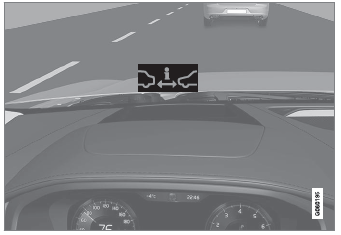Volvo XC90: Starting and driving / Driving through standing water
It may be necessary to drive the vehicle through standing water e.g. deep puddles or flooding on the road. This must be done with great caution.
The vehicle can be driven through water up to a depth of 45 cm (17 in) at no more than walking speed. Be particularly careful when driving through flowing water.
When driving through standing water, drive slowly and do not stop the vehicle. When you have passed the water, press lightly on the brake pedal and check that the brakes are functioning properly. Water, mud, slush, etc. can make the brake linings slippery, resulting in delayed braking effect.
- If the vehicle is equipped with contacts for an electric heater or trailer coupling, clean these after driving in water or mud.
- Do not allow the vehicle to stand in water up to the sills any longer than absolutely necessary. This could result in electrical malfunctions.
CAUTION
- Engine damage could occur if water enters the air cleaner.
- If water enters the transmission, the lubricating ability of the oils is reduced and the service life of these systems is shortened.
- Damage to any component, engine, transmission, turbocharger, differential or its internal components caused by flooding, vapor lock or insufficient oil is not covered under warranty.
- If the engine stalls while the vehicle is in water, do not attempt to restart it. Have the vehicle towed out of the water to a workshop. An authorized Volvo workshop is recommended. Risk of engine failure.
CAUTION
Because it can be difficult to determine the water depth, Volvo recommends not driving through standing or running water. The driver is always responsible for operating the vehicle in a safe manner and adhering to all applicable laws and regulations.
 Winter driving
Winter driving
It is important to check the vehicle before driving in cold/snowy conditions
to make sure it can be driven safely.
Before the cold season arrives:
Make sure the engine coolant contains 50% antifreeze...
 Opening/closing the fuel filler door
Opening/closing the fuel filler door
The vehicle must be unlocked before the fuel filler door can be opened1.
An arrow next to the fuel pump
symbol in the instrument panel indicates the side of the vehicle on which the fuel
filler door is located...
Other information:
Volvo XC90 2015-2025 Owners Manual: Operating the panoramic roof
(Option/accessory) The panoramic roof and sun curtain are operated using a control in the ceiling panel, and both are equipped with pinch protection. WARNING Children, other passengers or objects can be trapped by the moving parts. Always operate the windows with caution...
Volvo XC90 2015-2025 Owners Manual: Seat belt tensioners
The vehicle is equipped with standard and electric seat belt tensioners that can help tension the seat belt in a critical situation or collision. Standard seat belt tensioners All seat belts are equipped with a standard seat belt tensioner. In a collision of sufficiently violent force, the seat belt tensioners will tension the seat belts in order to more effectively restrain the occupants...

